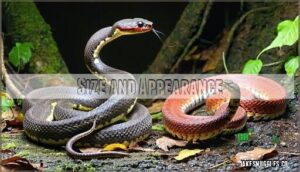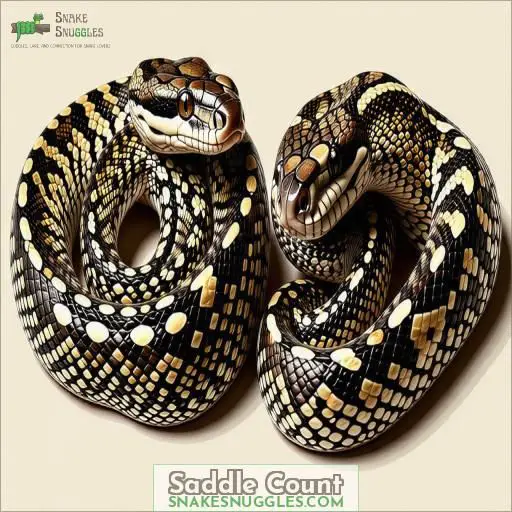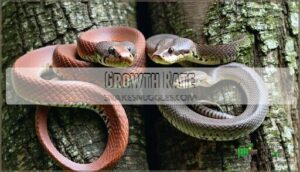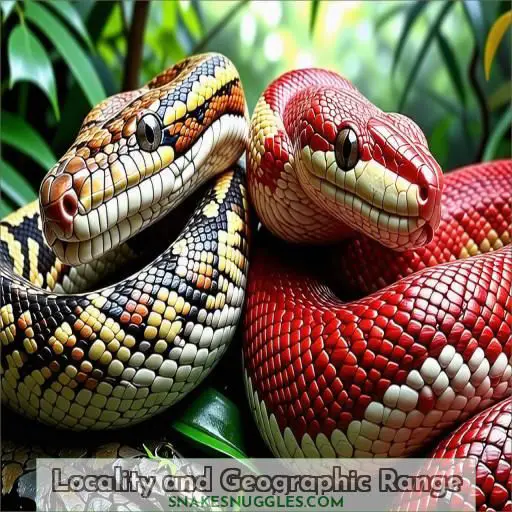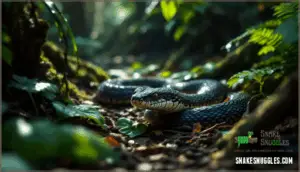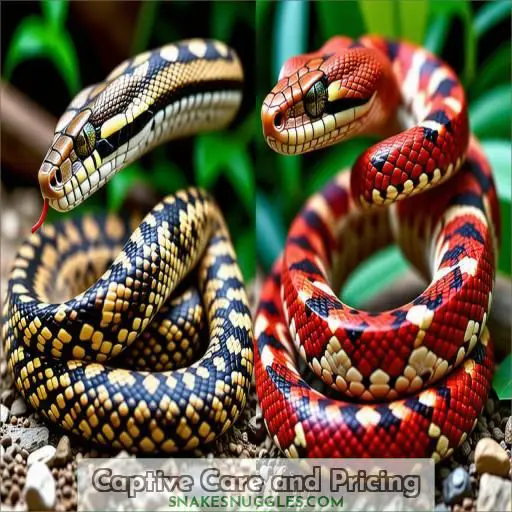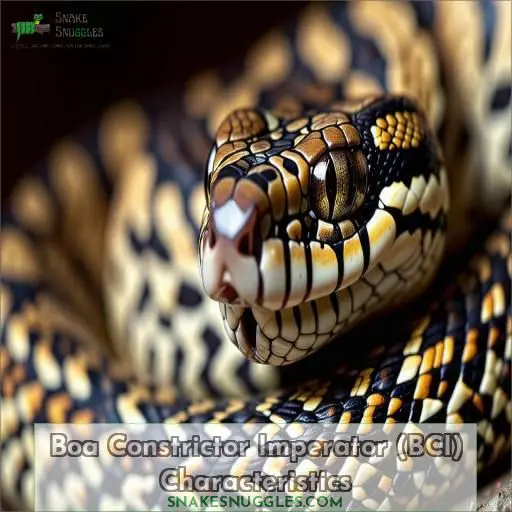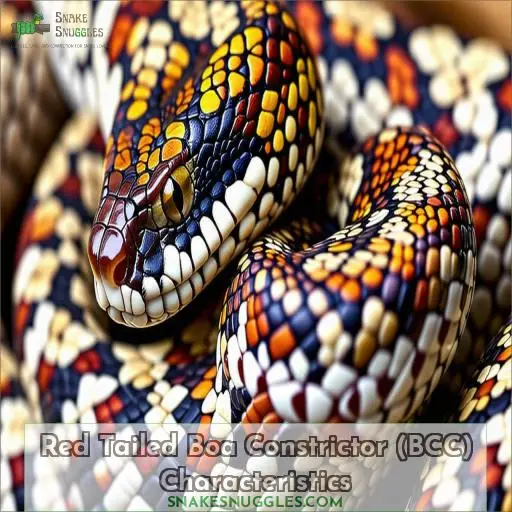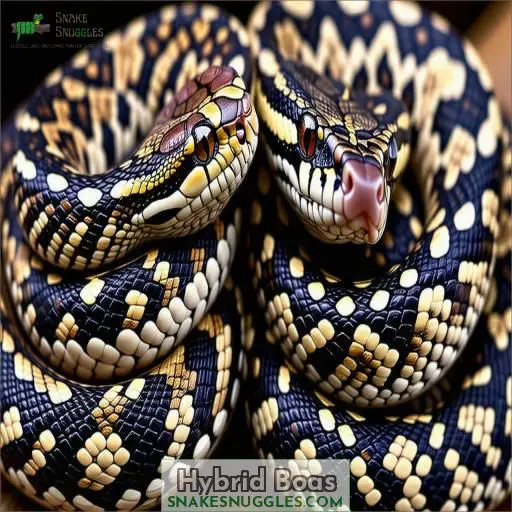This site is supported by our readers. We may earn a commission, at no cost to you, if you purchase through links.
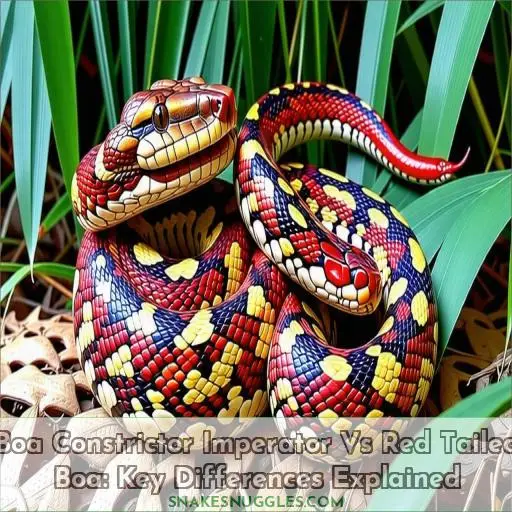
- Boa constrictor imperator (BCI) and Boa constrictor constrictor (BCC) are two distinct species of boa constrictors.
- BCI, found in Central America, has a thinner build, reaching 6-8 feet long.
- On the other hand, BCC, native to South America, can grow up to 10 feet (females 13 feet) with a girthier body.
- BCC has a brighter red tail compared to BCI’s reddish-brown.
- In terms of patterns, BCI has 22-30 evenly spaced saddles, while BCC has 15-22 saddles with a widow’s peak shape.
- While BCI grows faster, BCC reaches larger sizes.
- Additionally, BCI is generally calmer, while BCC can be more defensive.
- Moreover, captive BCI cost £50-100, while BCC are £150+.
Continue reading to learn more about these fascinating snakes!
Table Of Contents
- Key Takeaways
- Taxonomy and Subspecies
- Size and Appearance
- Saddle Count
- Growth Rate
- Locality and Geographic Range
- Behavior and Temperament
- Captive Care and Pricing
- Boa Constrictor Imperator (BCI) Characteristics
- Red Tailed Boa Constrictor (BCC) Characteristics
- Hybrid Boas
- Frequently Asked Questions (FAQs)
- What is the difference between Boa constrictor constrictor and boa constrictor imperator?
- Is a BCI a red tail boa?
- What is the difference between a BCI and a BCC?
- What is the friendliest Boa constrictor?
- How do I determine the sex of my boa?
- What do boa constrictors eat in the wild?
- How long do boa constrictors live in captivity?
- Can boa constrictors climb and swim well?
- Are boa constrictors good pets for beginners?
- Conclusion
Key Takeaways
- Boa constrictor imperator (BCI) and Boa constrictor constrictor (BCC) are distinct species with differences in size, appearance, and temperament. BCI is smaller, thinner, and generally more docile, while BCC is larger, stockier, and can be more defensive.
- BCI has 22-30 evenly spaced reddish-brown saddles, while BCC has 15-22 saddles with a widow’s peak shape and a brighter red tail. BCI grows faster but reaches smaller sizes compared to BCC.
- BCI is more affordable in captivity, costing £50-100, while BCC is more expensive at £150+. Many captive boas are hybrids of different subspecies, exhibiting a blend of characteristics from both BCI and BCC.
- Proper identification of subspecies is crucial for responsible ownership and conservation efforts. Understanding the unique traits of each species helps ensure their well-being in captivity and supports sustainable pet trade practices.
Taxonomy and Subspecies
The boa constrictor is a non-venomous snake native to the Americas, with 10 recognized subspecies. Boa constrictor imperator (BCI), also known as the common boa, is found in Central America and parts of Mexico, while Boa constrictor constrictor (BCC), the red-tailed boa, inhabits northern South America.
These subspecies have distinct geographic ranges and physical characteristics. Conservation efforts are essential, as some subspecies like the Argentine boa (B. c. occidentalis) are threatened due to habitat loss.
Understanding the taxonomy and geographic origins of these fascinating snakes is key to appreciating their diversity.
Size and Appearance
When comparing Boa Constrictor Imperator (BCI) and Red Tailed Boa Constrictor (BCC), one key difference lies in their size and appearance. BCI typically reaches 6-8 feet in length with a thinner build, while BCC can grow up to 10 feet (females up to 13 feet) and is girthier, with a deeper red tail compared to BCI .
BCI: 6-8 Feet Long, Thinner Build
Boa constrictor imperator, commonly known as the Central American boa or common boa, typically reaches lengths of 6-8 feet. They’ve a thinner build compared to their larger cousins, the red-tailed boa. Their markings consist of reddish-brown saddles along the body that become larger and rounder as they approach the tail .
BCC: 10 Feet Long (females Up to 13 Feet), Girthier
Red-tailed boas (BCC) are noticeably larger than their BCI counterparts, with females reaching lengths of up to 13 feet. Their stout build and girth set them apart, making BCC an impressive sight. Originating from northern South America, BCC exhibit a wide range of color variations in captivity due to selective breeding.
BCC Has a Deeper Red Tail Compared to BCI
When comparing the red tail color between Boa Constrictor Imperator (BCI) and Boa Constrictor Constrictor (BCC), it’s evident that BCC boasts a deeper red tail compared to BCI.
This difference in red intensity is one of the notable distinctions in appearance between the two boa constrictor subspecies. The brighter and more vivid red tail of the BCC sets it apart from the BCI, making it a distinguishing feature for those familiar with these snake species .
Saddle Count
One of the key differences between Boa constrictor imperator (BCI) and Boa constrictor constrictor (BCC) is the number of saddle markings on their bodies. While BCI typically have 22-30 saddles, BCC have fewer, ranging from 15-22 saddles .
BCI: 22-30 Saddles
Boa Constrictor Imperator, or the Central American Boa, typically displays 22-30 saddles along its body. These saddles are reddish-brown in coloration and become larger and rounder in the direction of the tail. The saddles are evenly spaced and have a consistent shape throughout the snake’s length. BCI breeders often focus on producing offspring with:
- Vibrant saddle coloration
- Uniform saddle shape and density
- Evenly distributed saddles along the body
While saddle count can vary, a BCI with 22-30 well-defined, reddish-brown saddles is a hallmark of the subspecies and a desirable trait in captive breeding programs.
BCC: 15-22 Saddles
In contrast to BCI, BCC typically display 15-22 saddles along their body. These saddles have a distinct widow’s peak shape, creating a more angular and striking pattern compared to the rounded saddles of BCI.
The saddles are often a deep reddish-brown color, standing out against the pale background of the BCC’s skin. While BCI may have more saddles, the larger size and unique shape of BCC saddles make them a defining characteristic of this subspecies.
The saddle count and pattern are just one of many visual cues that distinguish BCC from their BCI cousins.
Growth Rate
In terms of growth rate, Boa constrictor imperator (BCI) grows faster than Boa constrictor constrictor (BCC). However, while BCC grows slower, it ultimately reaches larger sizes compared to BCI .
BCI Grows Faster Than BCC
Boa constrictor imperator (BCI) matures faster than Boa constrictor constrictor (BCC). BCIs reach reproductive age around 2-3 years old, while BCCs take 3-4 years (Source). This faster growth rate allows BCIs to breed at a younger age. However, BCCs have a longer reproductive lifespan, breeding well into their teens . Proper husbandry is essential for both subspecies to thrive. With good care, BCIs can live 20-30 years, while BCCs may exceed 30 years (Source). Coloration also differs, with BCIs exhibiting reddish-brown saddles and BCCs having a distinct widow’s peak and vivid red tail .
- BCI matures faster, breeding at 2-3 years
- BCC takes 3-4 years to reach reproductive age
- BCCs have a longer reproductive lifespan
- Proper husbandry is key for longevity
BCC Grows Slower but Reaches Larger Sizes
It is known that the Red Tailed Boa Constrictor (BCC) grows slower than the Boa Constrictor Imperator (BCI) but reaches noticeably larger sizes, making it an intriguing subject for those interested in long-term growth and longevity comparisons. The BCC, with its slower growth rate, attains sizes up to 13-14 feet, while the BCI, although growing faster, maintains a size range of 6-8 feet. This difference in growth rates leads to distinct physical traits and temperament discrepancies between the two species, highlighting the importance of considering ideal habitat sizes for their long-term care.
| Aspect | BCC |
|---|---|
| Growth Rate | Slower than BCI |
| Maximum Size | 13-14 feet |
| Physical Traits | Bright and vivid red tails |
| Temperament | Can be more defensive and less handleable |
Locality and Geographic Range
The geographic ranges of BCI and BCC are quite distinct.
- BCI, or the Common Boa, is found west of the Andes Mountains, throughout Central America and parts of Mexico.
- In contrast, BCC, the Red-Tailed Boa, is native to South America east of the Andes, particularly in the Amazon rainforest.
This geographic isolation has led to differences in climate, habitat preferences, and prey species between the two subspecies. While BCC is more threatened by habitat loss, both are still found in the wild, though BCC is more common in captivity.
Behavior and Temperament
Regarding behavior and temperament, Boa constrictor imperator (BCI) is generally more docile and calm compared to Boa constrictor constrictor (BCC). While BCI snakes tend to be more handleable, BCC specimens can sometimes be more defensive and less tolerant of frequent handling .
BCI is Generally More Docile and Calm
Regarding their disposition, BCI boas are typically more amenable and composed compared to their BCC counterparts. This makes them suitable for first-time snake owners or those desiring a more manageable companion.
With appropriate handling methods and a well-cared-for captive environment, BCI boas can be highly interactive and form bonds with their owners.
However, it’s imperative to exercise caution and prioritize the snake’s well-being and health.
Conservation efforts are also essential for guaranteeing the continued existence of these magnificent reptiles in the wild.
BCC Can Be More Defensive and Less Handleable
While BCI boas are known for their calm demeanor, BCC boas can be more defensive and less handleable. Their territoriality may stem from habitat destruction in their native South American range. However, venom isn’t a concern, as both species are non-venomous constrictors.
Proper handling and gradual acclimation can help mitigate defensive behaviors. When breeding BCC boas, compatibility is key.
Conservation efforts aim to protect wild populations threatened by deforestation. With patience and understanding, even BCC boas can become docile pets for experienced reptile enthusiasts.
Captive Care and Pricing
Regarding captive care and pricing, there’s a significant disparity between the Boa Constrictor Imperator (BCI) and the Red Tailed Boa Constrictor (BCC). While the BCI is more affordable, ranging from £50-100, the BCC is a more expensive option, with prices starting at £150 or more.
BCI: £50-100
As a BCI owner, you’ll find them more affordable than their larger cousins. At £50-100, BCIs offer great value for money without breaking the bank. While their growth rate is faster, they max out at a manageable 6-8 feet.
Consider your budget constraints and the cost-effectiveness of a BCI if you’re looking for a boa on a tighter budget. Their calmer temperament also makes them a great choice for first-time boa owners.
Just be prepared for their voracious appetite and rapid growth in the early years!
BCC: £150+
The Red Tailed Boa Constrictor (BCC) is a stunning subspecies that demands a higher price tag of £150 or more in captivity. Its pale-gray, off-white, or cream background color provides a striking contrast to the reddish-brown saddle markings with a distinct widow’s peak. The BCC’s pointed, longer snout and bright, vivid red tail add to its allure. Native to northern South America, this subspecies can reach impressive lengths of 9-10 feet, with some females growing up to 13 feet. Its striking appearance and larger size contribute to its premium pricing in the reptile trade.
| Characteristic | BCC |
|---|---|
| Coloration | Pale-gray, off-white, or cream background with reddish-brown saddles and vivid red tail |
| Snout | Pointed and longer than BCI |
| Locality | Northern South America |
| Subspecies | Boa constrictor constrictor |
| Price | £150+ |
Boa Constrictor Imperator (BCI) Characteristics
Boa constrictor imperator, also known as the Central American boa or common boa, features reddish-brown saddle-shaped markings along its body. As you move in the direction of the tail, these saddles become larger and rounder in appearance.
Reddish-brown Saddles Along the Body
In Boa Constrictor Imperator (BCI), the prominent reddish-brown saddles along the body showcase distinct characteristics. These saddles vary in size, typically numbering between 22-30 along the snake’s length.
They maintain a uniform shape, enhancing the visual appeal of the boa with their striking pattern. The rich color of these saddles adds depth to the otherwise light cream to light brown background color of the BCI.
These saddles serve both aesthetic and functional purposes, contributing to the unique appearance of this particular subspecies.
Saddles Become Larger and Rounder on the Tail
As a Boa Constrictor Imperator matures, its saddle markings transform. The saddles become larger and rounder towards the tail, creating a striking visual effect.
The coloration also progresses, with the saddles changing from reddish-brown to a more pronounced brown hue. This gradual change in pattern and shade adds depth and interest to the snake’s appearance.
The tail itself is a key identifier, with the saddles becoming more defined and rounded as they reach the tip. Understanding these subtle shifts in saddle size, shape, and coloration is essential for accurately identifying a BCI specimen.
Red Tailed Boa Constrictor (BCC) Characteristics
Red-tailed boas (BCC) are distinguished by their saddles that have a distinct widow’s peak shape and their bright, vivid red tails. Compared to the common boa (BCI), BCCs have a lighter background color, are notably larger, and have skinnier necks .
Saddles Have a Distinct Widow’s Peak
The distinct widow’s peak shape of the saddles is a key identifying feature of the Red Tailed Boa Constrictor (BCC). These saddles are larger and more angular compared to the rounded saddles of the BCI.
The size variation in saddles also tends to be greater in BCC, with some saddles being quite small while others are very large. This variation likely stems from the BCC’s geographic distribution in northern South America, where genetic differences have emerged over time.
Unfortunately, wild BCC populations are threatened due to habitat loss, making conservation efforts essential for this striking subspecies.
Bright and Vivid Red Tails
The red tailed boa constrictor (BCC) is distinguished by its vivid, bright red tail coloration that contrasts strikingly with its pale gray, off-white, or cream background color. Unlike the BCI, the saddles of the BCC have a distinct widow’s peak shape, adding to its striking appearance.
- The red tail coloration is more vivid and intense compared to the BCI
- The saddles have a unique widow’s peak shape not seen in the BCI
- The bright red tail is a key identifying feature of the BCC
- The vividness of the red tail coloration is unmatched by the BCI
Hybrid Boas
Many captive boas are hybrids of different subspecies, so it’s important to understand that hybrids may exhibit characteristics of both Boa constrictor imperator (BCI) and Boa constrictor constrictor (BCC). When purchasing a boa, be aware that it could be a hybrid and may not fit neatly into the BCI or BCC categories in terms of size, appearance, or temperament.
Many Captive Boas Are Hybrids of Different Subspecies
Many captive boas are hybrids of different subspecies due to the popularity of these snakes as pets and the desire for unique color variations.
While this genetic diversity may be appealing, it’s critical to think about the implications for conservation efforts and responsible ownership.
Captive breeding practices should prioritize maintaining distinct subspecies to preserve their natural characteristics and support sustainable pet trade.
As a boa owner, research your snake’s lineage and provide appropriate care designed to meet its specific needs, ensuring the health and well-being of these fascinating reptiles.
Hybrids May Exhibit Characteristics of Both BCI and BCC
Hybrid Boas, resulting from the crossbreeding of BCI and BCC, exhibit a blend of characteristics from both subspecies, including color variations and size ranges .
The coloration and pattern may display traits from each parent, while size can vary widely depending on the specific hybridization. Temperament traits also reflect a combination of BCI’s docile nature and BCC’s potential defensiveness, creating a range of behavior in hybrid individuals.
Genetic diversity in hybrids contributes to their unique appearances and traits, necessitating versatile captive care requirements to suit the potential variety within this group .
Frequently Asked Questions (FAQs)
What is the difference between Boa constrictor constrictor and boa constrictor imperator?
Boa constrictor constrictor and Boa constrictor imperator, once considered subspecies, are now recognized as distinct species. BCC, the true red-tailed boa, is larger and lighter in color compared to the smaller, darker BCI from Central America .
Is a BCI a red tail boa?
No, a BCI (Boa constrictor imperator) isn’t a red-tailed boa. BCI is a separate species from the red-tailed boa (Boa constrictor constrictor), which has a brighter red tail and larger size .
What is the difference between a BCI and a BCC?
Although both are Boa constrictors, BCI (Boa constrictor imperator) and BCC (Boa constrictor constrictor) are distinct species with key differences in size, coloration, and temperament. BCC, the true red-tailed boa, is larger, stockier, and often calmer than the slender, faster-growing BCI.
What is the friendliest Boa constrictor?
The Central American Boa (BCI) is generally considered the friendliest Boa constrictor subspecies. BCIs are known for their calm temperament and docile nature, making them a popular choice for beginner snake owners .
How do I determine the sex of my boa?
To determine the sex of your boa, you can visually examine the tail base, where male boas have longer and thicker spurs, which are small raised scales, compared to female boas. Another way is to probe the snake to detect the presence or absence of hemipenes.
What do boa constrictors eat in the wild?
In the wild, boa constrictors primarily eat small mammals like rodents and bats. They use their keen sense of smell to locate prey, then coil around it, constricting until the animal suffocates .
How long do boa constrictors live in captivity?
Boa constrictors can live 20-30 years in the wild, but can exceed 40 years in captivity with proper care . Provide a large enclosure, appropriate temperatures, humidity, and a varied diet to help your boa thrive for decades.
Can boa constrictors climb and swim well?
Boa constrictors are excellent climbers, using their muscular bodies and prehensile tails to scale trees and rocks. They’re also accomplished swimmers, gliding gracefully through water to hunt or escape predators. Their adaptability helps them thrive in diverse habitats.
Are boa constrictors good pets for beginners?
Boa constrictors can make great pets for beginners, but they’re not for the faint of heart. These gentle giants require commitment, space, and a steady diet of rodents to thrive in captivity. Are you up for the challenge?
Conclusion
Explore the distinct characteristics of Boa constrictor imperator and Red Tailed Boa constrictor to understand their differences better.
From size and appearance to behavior and temperament, these two species showcase unique traits that cater to different preferences in snake enthusiasts.
Whether considering growth rates, saddle counts, or captive care costs, the nuances between BCI and BCC offer valuable insights for those looking to


